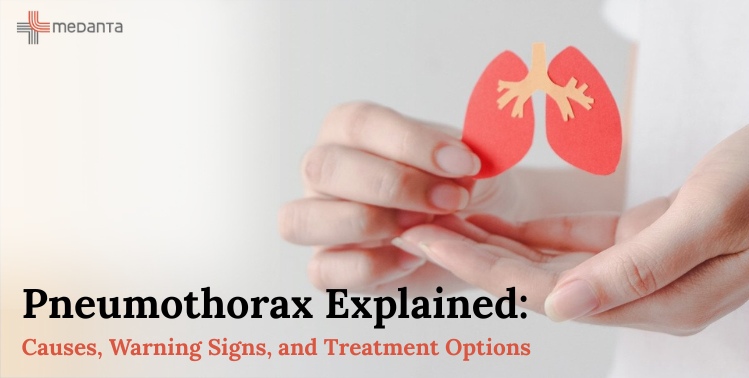Pneumothorax, commonly referred to as a collapsed lung, is a medical condition where air leaks into the space between the lungs and chest wall. This air build-up puts pressure on the lung, causing it to collapse partially or completely. Pneumothorax can occur suddenly and requires immediate medical attention in many cases. Understanding the causes, symptoms, and treatment options for pneumothorax is crucial for timely intervention and recovery.
What is Pneumothorax?
Pneumothorax occurs when air escapes from the lung or enters the pleural space—the thin cavity between the lung and chest wall. This air can accumulate due to injury, lung disease, or medical procedures. As the pressure increases, the lung may collapse, impairing the patient’s ability to breathe effectively.
There are several types of pneumothorax:
- Spontaneous Pneumothorax – Occurs without any trauma or known cause. It’s divided into:
- Primary spontaneous pneumothorax (PSP): Usually affects healthy individuals, often tall, thin males in their 20s or 30s.
- Secondary spontaneous pneumothorax (SSP): Occurs in people with pre-existing lung diseases like COPD, asthma, cystic fibrosis, or tuberculosis.
- Traumatic Pneumothorax – Caused by blunt or penetrating chest injury.
- Tension Pneumothorax – A life-threatening condition where pressure builds up rapidly in the pleural cavity, compressing the lung and shifting mediastinal structures.
- Iatrogenic Pneumothorax – Caused by medical procedures such as lung biopsies, central line insertion, or mechanical ventilation.
Causes of Pneumothorax
The causes of pneumothorax vary depending on the type but generally include:
- Lung Diseases: Chronic obstructive pulmonary disease (COPD), pneumonia, cystic fibrosis, and lung cancer can increase the risk.
- Chest Trauma: A broken rib, stab wound, or gunshot can puncture the lung.
- Medical Procedures: Invasive procedures involving the lungs or chest can inadvertently cause pneumothorax.
- Mechanical Ventilation: High-pressure ventilators may cause barotrauma, leading to air leaks.
- Smoking: Increases the risk of primary spontaneous pneumothorax.
- Genetic Factors: Some individuals are genetically predisposed to weak spots in the lungs.
Signs and Symptoms of Pneumothorax
Recognizing the symptoms of pneumothorax is vital for early intervention. The most common symptoms include:
- Sudden, sharp chest pain, usually on one side
- Shortness of breath
- Rapid breathing or tachypnea
- Cyanosis (bluish skin)
- Fatigue or dizziness
- Decreased or absent breath sounds on the affected side
- Tightness in the chest
In severe cases, especially with tension pneumothorax, symptoms can progress to:
- Low blood pressure
- Fast heart rate
- Distended neck veins
- Confusion or loss of consciousness
How is Pneumothorax Diagnosed?
A prompt diagnosis is essential for effective treatment. Healthcare professionals use the following tools:
- Physical Examination:
- Listening to breath sounds with a stethoscope.
- Checking for chest expansion and respiratory distress.
- Chest X-ray:
- The most common imaging tool used to confirm the presence and extent of pneumothorax.
- CT Scan:
- Provides more detailed images, especially helpful in complex or recurrent cases.
- Ultrasound:
- Increasingly used in emergency settings for rapid diagnosis.
Treatment Options for Pneumothorax
The treatment for pneumothorax depends on its size, cause, and severity. Common options include:
- Observation
Small, stable pneumothoraces (especially primary spontaneous pneumothorax) may resolve on their own. Patients are monitored with repeat imaging and oxygen therapy.
- Oxygen Therapy
High-concentration oxygen can speed up the reabsorption of air from the pleural space, especially in minor cases.
- Needle Aspiration
Involves using a syringe to remove air from the pleural cavity. Often used in less severe or first-time cases.
- Chest Tube Insertion (Thoracostomy)
A flexible tube is inserted into the chest cavity to continuously remove air, allowing the lung to re-expand. This is the standard treatment for moderate to large pneumothorax.
- Surgery
For recurrent pneumothorax or when less invasive measures fail, surgery may be required. Procedures include:
- Video-Assisted Thoracoscopic Surgery (VATS): Minimally invasive, used to repair lung defects and prevent recurrence.
- Pleurodesis: A procedure that causes the lung to stick to the chest wall, reducing recurrence risk.
Recovery and Prognosis
Recovery from pneumothorax depends on the severity, underlying cause, and treatment method. Most patients recover fully with appropriate care. However, recurrence is common, especially in spontaneous pneumothorax cases—affecting up to 30% of individuals.
Lifestyle and Prevention Tips:
- Quit Smoking: Reduces risk of recurrence.
- Avoid High-Altitude or Scuba Diving: Sudden pressure changes can trigger pneumothorax.
- Regular Medical Checkups: Especially for individuals with underlying lung conditions.
- Follow Post-Surgery Instructions: Adhering to post-operative guidelines ensures faster recovery and fewer complications.
Complications of Pneumothorax
Untreated or severe pneumothorax can lead to:
- Respiratory failure
- Hem thorax (blood in the chest cavity)
- Tension pneumothorax
- Cardiac arrest
Timely diagnosis and treatment are essential to prevent complications and ensure full lung function is restored.
